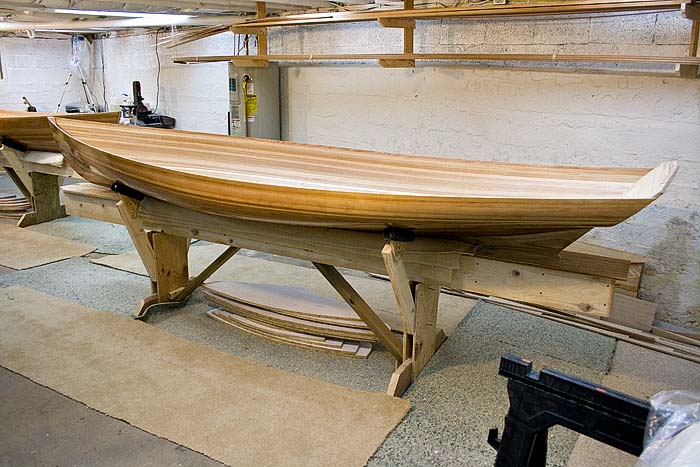North hull ready for framing
Flipped both hulls this weekend, and added braces to the strongbacks to hold everything steady for framing and decking. Scraping glue drips off the insides went pretty quick, as there was minimal glue squeeze out, and what was there just popped right off. I’m changing the order of things a bit, so won’t do the final sanding and glassing of the interiors for a while yet.
Flipping a hull marks a major milestone in a build, moving from the first big phase to the next. At this point you can take a breath, and get to walk around and admire the shapes and colors while you plan out phase two.
The two buddies who helped me do the flipping sat around for awhile admiring the view, too. One is a fishing buddy who wants to try sailing, the other was a professional high end cabinet maker, and he told me about a local guy who has some large milling equipment that may come in handy later. It’s nice to have friends.
Next up is ripping planks for the decks.
melonseed skiff, mellonseed skiff, melon seed, mellon seed







Barry, I am about to glass the outside of my hull. If the inside remains unsealed for the duration of the winter and all it’s violent humidity changes, will the hull warp beyond all recognition? Could it destroy the boat?
Thanks.
Jayson
Good question Jayson! You’ve either read waaaay ahead, or are thinking ahead, or both.
If you live in a place with wild swings in humidity between summer and winter, any piece of wood glassed on one side will experience a lot of stress from the changes. The boat will not be destroyed, but parts may indeed warp. I glassed the outside at the end of winter when everything was very dry. By the end of summer working in a damp basement some parts had warped. My case may be extreme – as I recall, the basement flooded that summer, so the humidity stayed unusually high for months.
The only two places where it was actually a problem were the flat sections – the keel plank and the transom. My keels have a permanent cup. I didn’t figure out why until later, but by then couldn’t do anything about it. Not terrible, but definitely not ideal. Once I figured out what was happening, I tried keeping the concrete floor wet for days at a time in winter, which helped some, but not enough.
On my boats the transoms are laminated. Knowing I was going to glue on an outer layer, I didn’t glass that part on the outside with the rest of the hull, so these had the opposite problem – when I glassed the inside, the outside was still raw until time to glue on the walnut.The inner transom layer was so warped there was no way I add the outer final layer of walnut. I put towel in a bucket of water like a wick, and wrapped the bucket and the transoms in a tent of plastic and left them like that for two weeks. That took enough warp out I could work with it.
If I were to do it again I would flip the boats as soon as the outside is glassed and immediately do the inside. There are actually very few things that need to glue wood to wood on the insides of the boats later, so there’s little harm in doing it then. The framing – which takes a looong time – can be done on a fully glassed hull, as it’s all glued and screwed. You can rough up the surface of the cured epoxy and get a reasonably good bond with fresh epoxy. I think that’s better than what I did, being over cautious about getting the best wood to wood bond wherever possible.